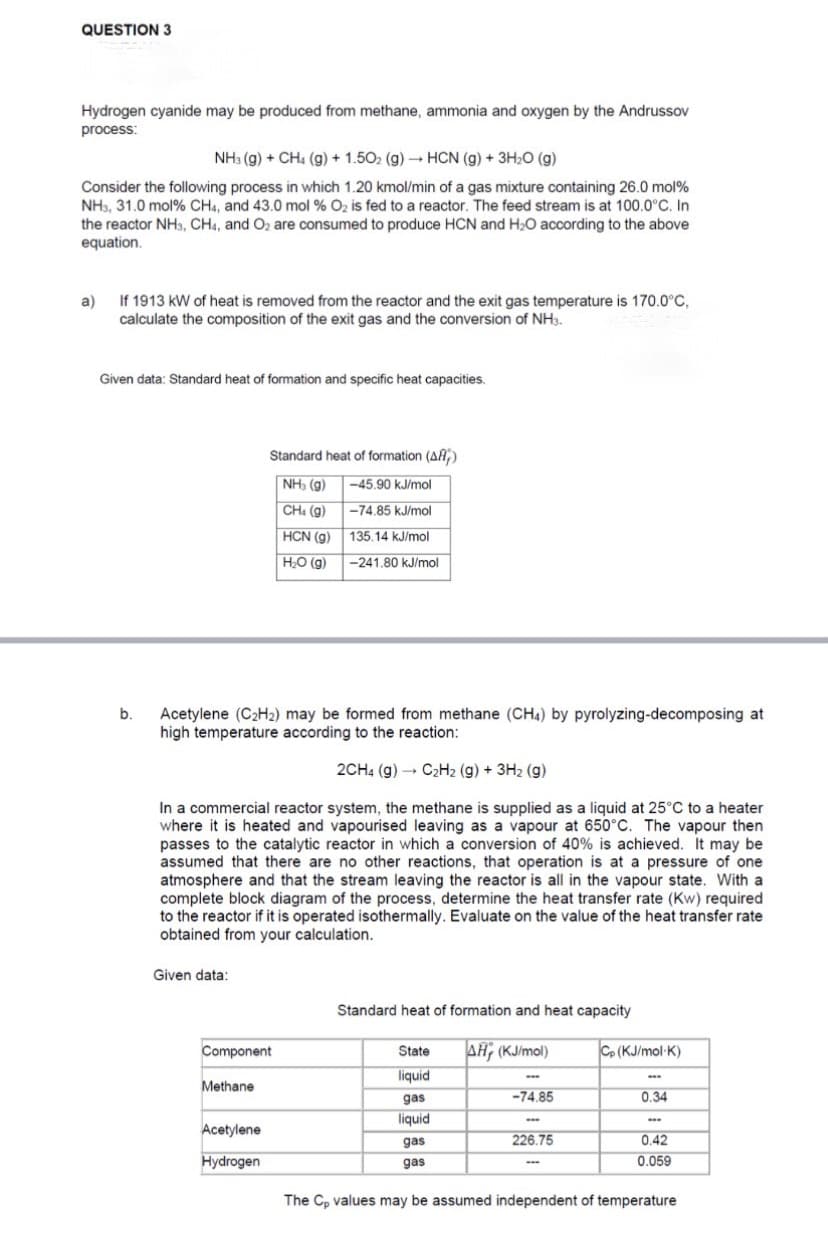Hydrogen cyanide may be produced from methane, ammonia and oxygen by the Andrussov process: NH3(g) + CH. (g) + 1.50₂ (g) → HCN (g) + 3H₂O(g) Consider the following process in which 1.20 kmol/min of a gas mixture containing 26.0 mol% NH3, 31.0 mol % CH4, and 43.0 mol % O₂ is fed to a reactor. The feed stream is at 100.0°C. In the reactor NH3, CH4, and O₂ are consumed to produce HCN and H₂O according to the above equation. a) If 1913 kW of heat is removed from the reactor and the exit gas temperature is 170.0°C, calculate the composition of the exit gas and the conversion of NH3. Given data: Standard heat of formation and specific heat capacities. Standard heat of formation (AA) NH, (9) CH₂ (g) HCN (g) H₂O (g) -45.90 kJ/mol -74.85 kJ/mol 135.14 kJ/mol -241.80 kJ/mol
Hydrogen cyanide may be produced from methane, ammonia and oxygen by the Andrussov process: NH3(g) + CH. (g) + 1.50₂ (g) → HCN (g) + 3H₂O(g) Consider the following process in which 1.20 kmol/min of a gas mixture containing 26.0 mol% NH3, 31.0 mol % CH4, and 43.0 mol % O₂ is fed to a reactor. The feed stream is at 100.0°C. In the reactor NH3, CH4, and O₂ are consumed to produce HCN and H₂O according to the above equation. a) If 1913 kW of heat is removed from the reactor and the exit gas temperature is 170.0°C, calculate the composition of the exit gas and the conversion of NH3. Given data: Standard heat of formation and specific heat capacities. Standard heat of formation (AA) NH, (9) CH₂ (g) HCN (g) H₂O (g) -45.90 kJ/mol -74.85 kJ/mol 135.14 kJ/mol -241.80 kJ/mol
Introduction to Chemical Engineering Thermodynamics
8th Edition
ISBN:9781259696527
Author:J.M. Smith Termodinamica en ingenieria quimica, Hendrick C Van Ness, Michael Abbott, Mark Swihart
Publisher:J.M. Smith Termodinamica en ingenieria quimica, Hendrick C Van Ness, Michael Abbott, Mark Swihart
Chapter1: Introduction
Section: Chapter Questions
Problem 1.1P
Related questions
Question

Transcribed Image Text:QUESTION 3
Hydrogen cyanide may be produced from methane, ammonia and oxygen by the Andrussov
process:
NH3(g) + CH4 (g) + 1.50₂ (g) → HCN (g) + 3H₂O (g)
Consider the following process in which 1.20 kmol/min of a gas mixture containing 26.0 mol%
NH3, 31.0 mol % CH4, and 43.0 mol % O₂ is fed to a reactor. The feed stream is at 100.0°C. In
the reactor NH3, CH4, and O₂ are consumed to produce HCN and H₂O according to the above
equation.
a)
If 1913 kW of heat is removed from the reactor and the exit gas temperature is 170.0°C,
calculate the composition of the exit gas and the conversion of NH3.
Given data: Standard heat of formation and specific heat capacities.
b.
Given data:
Acetylene (C₂H₂) may be formed from methane (CH4) by pyrolyzing-decomposing at
high temperature according to the reaction:
2CH4 (g) → C₂H₂ (g) + 3H₂(g)
In a commercial reactor system, the methane is supplied as a liquid at 25°C to a heater
where it is heated and vapourised leaving as a vapour at 650°C. The vapour then
passes to the catalytic reactor in which a conversion of 40% is achieved. It may be
assumed that there are no other reactions, that operation is at a pressure of one
atmosphere and that the stream leaving the reactor is all in the vapour state. With a
complete block diagram of the process, determine the heat transfer rate (Kw) required
to the reactor if it is operated isothermally. Evaluate on the value of the heat transfer rate
obtained from your calculation.
Standard heat of formation (AF)
NH3 (9)
CH₁ (g)
HCN (g)
H₂O (g)
Component
Methane
Acetylene
Hydrogen
-45.90 kJ/mol
-74.85 kJ/mol
135.14 kJ/mol
-241.80 kJ/mol
Standard heat of formation and heat capacity
AH (KJ/mol)
State
liquid
gas
liquid
gas
gas
-74.85
www
226.75
Cp (KJ/mol-K)
www
0.34
ww
0.42
0.059
The Cp values may be assumed independent of temperature
Expert Solution
This question has been solved!
Explore an expertly crafted, step-by-step solution for a thorough understanding of key concepts.
Step by step
Solved in 7 steps with 7 images

Recommended textbooks for you

Introduction to Chemical Engineering Thermodynami…
Chemical Engineering
ISBN:
9781259696527
Author:
J.M. Smith Termodinamica en ingenieria quimica, Hendrick C Van Ness, Michael Abbott, Mark Swihart
Publisher:
McGraw-Hill Education

Elementary Principles of Chemical Processes, Bind…
Chemical Engineering
ISBN:
9781118431221
Author:
Richard M. Felder, Ronald W. Rousseau, Lisa G. Bullard
Publisher:
WILEY

Elements of Chemical Reaction Engineering (5th Ed…
Chemical Engineering
ISBN:
9780133887518
Author:
H. Scott Fogler
Publisher:
Prentice Hall

Introduction to Chemical Engineering Thermodynami…
Chemical Engineering
ISBN:
9781259696527
Author:
J.M. Smith Termodinamica en ingenieria quimica, Hendrick C Van Ness, Michael Abbott, Mark Swihart
Publisher:
McGraw-Hill Education

Elementary Principles of Chemical Processes, Bind…
Chemical Engineering
ISBN:
9781118431221
Author:
Richard M. Felder, Ronald W. Rousseau, Lisa G. Bullard
Publisher:
WILEY

Elements of Chemical Reaction Engineering (5th Ed…
Chemical Engineering
ISBN:
9780133887518
Author:
H. Scott Fogler
Publisher:
Prentice Hall


Industrial Plastics: Theory and Applications
Chemical Engineering
ISBN:
9781285061238
Author:
Lokensgard, Erik
Publisher:
Delmar Cengage Learning

Unit Operations of Chemical Engineering
Chemical Engineering
ISBN:
9780072848236
Author:
Warren McCabe, Julian C. Smith, Peter Harriott
Publisher:
McGraw-Hill Companies, The